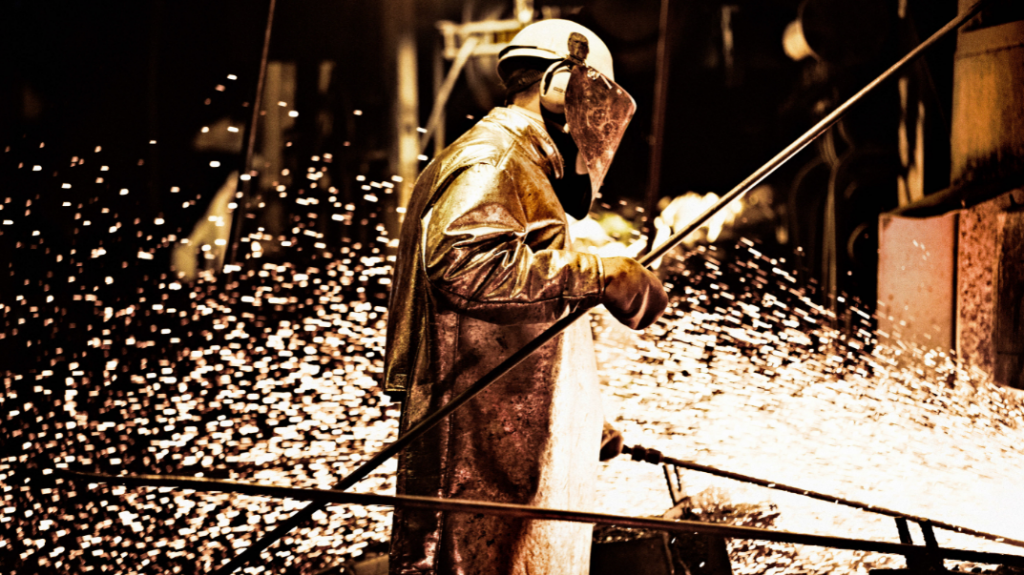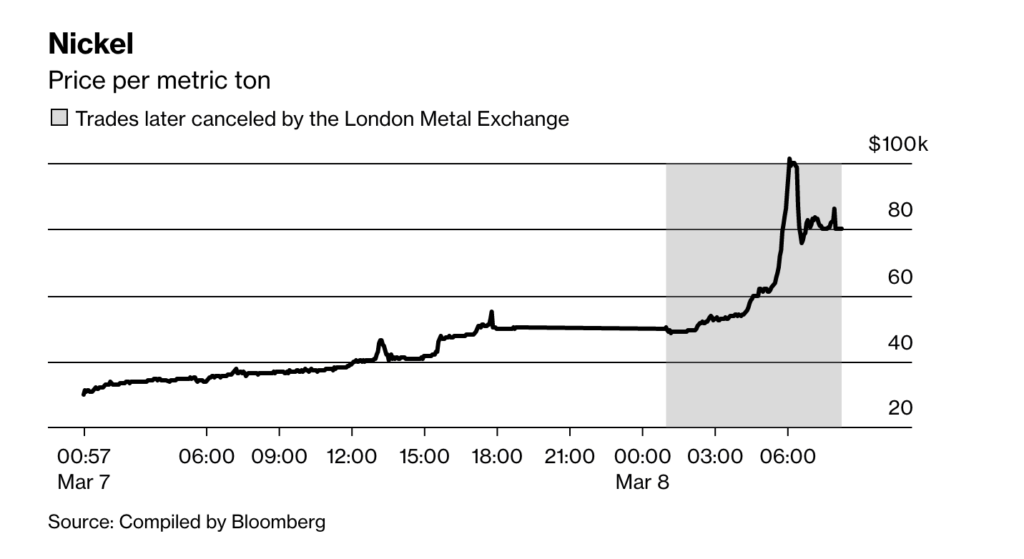The 18 minutes of trading chaos that broke the nickel market

It was 5:42 a.m. on March 8 in London when the nickel market broke. At that time of day, bleary-eyed traders are typically just glancing at prices as they swig coffee on their way to the office.
On this day, however, metal traders across the city were glued to a screen, watching the price action on the electronic market, which was already open to accommodate Asian trading. Nickel prices usually move a few hundred dollars per ton in a day. For most of the past decade, they’d traded between $10,000 and $20,000.
Yet the day before, the market had started to unravel, with prices rising by a stunning 66% to $48,078. Now, the traders watched with a mixture of horror and grim fascination as the price went vertical. Already at an all-time high by 5:42 a.m., it lurched higher in stomach-churning leaps, soaring $30,000 in a matter of minutes. Just after 6 a.m., the price of nickel passed $100,000 a ton.
For participants in commodities exchanges, a price rally is not necessarily good news. Miners, traders, and manufacturers often use the market to make short bets—that is, to make money when prices fall. And when those wagers move violently in the opposite direction, they can be hit with huge margin calls, or requests to put down more cash to back their trades.
The head of one London metals brokerage recalls feeling sick as he watched the moves, realizing what the spike in prices would mean for his company, the market, and the global metals industry. “Those 18 minutes will haunt me,” says the executive, who wasn’t authorized to speak publicly.

Nickel’s 250% price spike in little more than 24 hours plunged the industry into chaos, triggering billions of dollars in losses for traders who bet the wrong way and leading the London Metal Exchange to suspend trading for the first time in three decades. It marked the first major market failure since Russia’s invasion of Ukraine jolted global markets, showing how the removal of one of the world’s largest exporters of resources from the financial system in the space of weeks is having ripple effects across the world.
The big short
The spike was driven in large part by a short squeeze centered on Chinese tycoon Xiang Guangda, who had amassed a big wager that nickel prices would fall through his company Tsingshan Holding Group Co. On Monday, a week after trading had been suspended, Xiang was close to securing a loan facility from JPMorgan Chase & Co. and other banks that would allow him to maintain his short position and could lead to the market reopening.
In a squeeze, rising prices put traders betting on a drop in an ever-tougher financial position, forcing them or brokers and banks doing business on their behalf to buy the asset, a trade known as short covering that can drive prices even higher. Others in the market may also push up prices in anticipation of that short covering. The wild rise of nickel drew comparisons to the short squeezes in meme stocks such as GameStop Corp. that gripped retail investors for much of last year.
The difference is that nickel is a commodity that touches the entire global economy. The metal is found in all our homes as a key ingredient of stainless steel. It’s also one of the most important raw materials needed in making batteries for electric vehicles. “This was the most disorderly move in a metal I’ve seen in my career,” says Mark Hansen, chief executive officer of trading house Concord Resources Ltd. “We had a frenzy based on speculation that accelerated on Monday and Tuesday. People forgot that this isn’t a video game retailer; it’s an important physical commodity.”
The seeds of the epic short squeeze were sown last year, when nickel, like all commodities, was rallying from its Covid-era low. Xiang didn’t believe the rally would last. He started increasing his short position on the London Metal Exchange. The LME’s history dates back to the early 19th century, when metal traders drew a circle in the sawdust on the floor of the Jerusalem Coffee House in the City of London. Today, in addition to its electronic market, it’s one of the last exchanges where brokers still gather in person to yell orders at one another for part of the day. Its participants are a mix of the industrial metals companies, which tap the market to offset their price risks, and hedge funds, which use it to speculate. Still, contracts on the LME are backed by physical metal in a network of warehouses around the world, providing a direct link with the real-world metals industry.
Xiang isn’t just a financial trader making paper bets on price moves. He’s in the physical nickel business. Born in 1958, he started out making frames for car doors and windows in Wenzhou, in eastern China. He went on to pioneer new methods for producing nickel and stainless steel that upended the markets and made his Tsingshan the world’s largest producer of both. Nicknamed “Big Shot” in Chinese commodity circles, people who know him say he has absolute confidence in his convictions and doesn’t hesitate to bet big on his visions for the future. (This account of events in the nickel market is based on dozens of interviews with people involved, many of whom requested anonymity because the matters are private.)
Why bet against nickel when you have a nickel business? Xiang wanted to increase Tsingshan’s production dramatically by producing so-called nickel matte for electric vehicle batteries. The company had plans to produce 850,000 tons of nickel in 2022, an increase of 40% in a year, according to a person briefed on them. While few observers believed Xiang could reach that level of production, he was confident. But the obvious consequence of so much nickel hitting the market, he believed, would be a fall in its price.
Not everyone shared his pessimism about prices. Some hedge funds were buying nickel contracts in a bet on the electric vehicle boom. The giant commodity trader Glencore Plc also had a position on the LME that would benefit from rising prices. By early this year, it had taken ownership of more than half of the available nickel in LME warehouses. For a while, it was unclear which view of the market would prevail. Most analysts sided with Xiang, at least in the medium term, believing that nickel production—led by Tsingshan and its competitors in Indonesia—would outpace demand.
Everything changed when Russia invaded Ukraine. Russia is the world’s third-largest producer of nickel and its largest exporter of refined nickel metal—the type deliverable on the LME. While Russia’s nickel exports haven’t been targeted by sanctions, U.S. and European buyers have nonetheless sought alternatives to Russian sources.
Nickel’s price moved sharply higher in the week after Russia’s invasion. For Xiang’s big short position, that was painful. Remember, when prices move up, traders like Xiang who have sold futures contracts face margin calls; they must put up more cash to cover potential losses.
While investors who sell stocks short want the price to drop, in commodity markets many producers, traders, and users take short positions as a hedge against losses on the physical commodities they hold in inventories. In theory, any price changes on the futures market should offset price changes in the value of the inventories—as long as the traders can meet their margin calls.
It’s not clear to what extent Xiang saw his position as merely a hedge or as a speculative bet. The annals of commodity markets are full of tales of producers and traders, from Metallgesellschaft to Sumitomo, that blurred the lines between hedging and speculation and ended with billions of dollars in losses.
In late February and early March, Tsingshan, which had sales of 352 billion yuan ($56 billion) last year, paid its margin calls on time. Then on March 7, nickel’s price began its parabolic ascent, surging from $30,000 a ton to more than $50,000. LME brokers and their clients were hit with margin call after margin call. Several large brokers got margin calls of close to $1 billion each over the course of the day.
Tsingshan’s were even larger, numbering roughly $3 billion, according to a Bloomberg calculation based on the company’s total short position—which, even after Xiang had closed out a portion of the bet in previous weeks, was over 150,000 tons. The company paid at least some of its margin calls early on Monday, according to a person familiar with the matter. But its obligations dwarfed its available cash and bank credit. As the price rose through the London day after offices in Asia had closed, Tsingshan started struggling to pay, the people say.
That put Tsingshan’s banks and brokers, which include JPMorgan Chase, BNP Paribas, and Standard Chartered, in a bind. They had offset their deals with Tsingshan by placing their own short positions on the LME. Now they had to pay big margin calls on the exchange while receiving no margin from their client. Some started hurrying to buy back nickel contracts, sending the price of nickel spiraling ever higher. It was a classic short squeeze, as the pain for Tsingshan, its brokers, and other shorts created a self-reinforcing cycle.
Crisis mode
By now, the entire nickel industry was in crisis. The LME convened its “special committee,” a small group of metals and legal experts with the power to issue emergency rules for the market. They held a hurried call on Monday evening, but decided to allow the nickel market to continue trading.
At 1 a.m. on Tuesday, the market opened. Matthew Chamberlain, the LME’s chief executive officer, had stayed up to watch. Things seemed calm at first: Prices were hovering around $50,000 a ton, and he went to bed. He was awakened by a phone call at 5:30 a.m. The nickel market was anything but calm. Worse, the chaos was spreading to other markets: Zinc prices spiked 15% in a few minutes to a record high, only to collapse again.
The LME’s special committee held another call at about 6 a.m. Now they recognized that they had to suspend trading. At 8:15 a.m., the screens stopped flashing, hours before the in-person pit trading session was even set to begin. The price was frozen, below the record high but still at $80,000 a ton. Soon Chamberlain and other executives at the exchange began receiving frantic phone calls from LME brokers.
By now, Tsingshan wasn’t the only nickel company that was struggling—just the biggest. Many producers, traders, and users of nickel with short positions on the LME were facing margin calls many times larger than they were prepared for. “When it was flying towards $100,000, you could feel the damage, and you knew companies were fighting for their existence,” says John Browning, founding partner of brokerage Bands Financial Ltd. and a former LME board member.
At the current price of nickel, the brokers themselves wouldn’t be able to pay their margin calls, they told the LME. Four or five of the brokerages that are LME members would have failed, a shock that could have devastated the global metals industry. The price move on March 8 “created a systemic risk to the market,” the LME said two days later. The exchange had “serious concerns about the ability of market participants to meet their resulting margin calls, raising the significant risk of multiple defaults.” Despite that, Chamberlain insisted to Bloomberg TV on March 9 that the solvency of the LME itself was never in doubt.
The LME made a near-unprecedented decision. It decided to cancel all the trades that took place on Tuesday morning—$3.9 billion of them, according to a Bloomberg calculation. Exchanges sometimes cancel trades when technology glitches or “fat fingers” cause one-off mistakes. But it’s extremely unusual for an exchange to cancel whole sessions of trading after the fact. Crucially, the decision meant traders wouldn’t need to pay margin calls on the basis of the $80,000 nickel price. Effectively, it rewound the market to the moment when prices closed on Monday at $48,078.
Even at that level, clients of LME brokers had failed to pay some $500 million of margin calls in relation to their short positions on the exchange, according to a person familiar with the matter. Tsingshan accounted for about half that amount. And that was just for the portion of the short position it held directly on the exchange—about 30,000 tons. The company had a further 120,000 tons or more in short positions off the exchange, in bilateral deals with such banks as JPMorgan Chase & Co. and Standard Chartered Plc.
Infuriated investors
The fallout was immediate. Investors who had booked trades during the chaotic session in the early hours of Tuesday were furious. Among them were some of the biggest names on Wall Street. Executives from Goldman Sachs Group Inc. voiced their displeasure at the decision on a call with Chamberlain. Executives at Tower Research Capital, one of Wall Street’s oldest electronic market-makers, reined in its trading activity on the LME and put its membership in the exchange under review.
Others took to social media. “For the LME to cancel nickel trades between willing buyers and sellers is unforgiveable. UNFORGIVEABLE,” tweeted Mark Thompson, a former trader at Trafigura and Apollo. Cliff Asness, founder of AQR Capital Management, accused the LME, which was for more than a century owned by its members but in 2012 was sold to Hong Kong Exchanges & Clearing, of “stealing money from market participants trading in good faith and giving it to Chinese nickel producers and their banks.” LME’s Chamberlain defended canceling the trades. “Our fundamental responsibility is market stability,” he told Bloomberg TV. “The prices that were being seen during that Asian session were becoming disconnected from, I believe, physical reality.”
Xiang’s short position has now racked up billions of dollars in losses. Undeterred, the Chinese tycoon has told banks he wants to maintain his position, and has asked them to keep funding him despite the losses. It’s unclear whether he will get his way. One resolution to the situation may be for Glencore and Xiang to strike a deal to use Glencore’s long positions to cancel out some of Xiang’s short. Neither party seems very keen on this idea, however. The Chinese government may also play a role. Beijing is supportive of him, Xiang told contacts recently. One thing is sure: If Xiang can weather the storm, Tsingshan’s nickel producing assets stand to benefit from the higher prices, offsetting losses from the short.
For the LME, the future is unclear. As of the evening of March 13, the LME had yet to announce a date for nickel trading to resume. People familiar with the discussions said the exchange would ideally prefer to wait until Xiang has reached a resolution with his banks and brokers. In the meantime, the nickel market is on ice, with traders unable to exit their positions, and many billions of dollars tied up in margin calls. Some think this could herald the end of the exchange itself.
“The LME is now very likely going to die a slow, self-inflicted death through the loss of confidence in it and its products,” predicted Thompson in a tweet. Still, the LME has weathered numerous scandals before in its 145-year history, from a 1985 crisis in the tin market that caused many brokers to go out of business to the incident when a trader at Sumitomo hid more than $2 billion in losses.
Those past scandals forced reforms on the exchange. Now, people familiar with the matter say, the exchange is likely to introduce such measures as position limits and greater transparency. Most market participants expect nickel prices to come back down once the crisis around Xiang’s position has been resolved.
But the effects of the short squeeze are likely to be felt in other ways. Some aggrieved traders are already preparing to take legal action against the exchange. There are also traders making plans to abandon the LME nickel contract, a move that would reduce market liquidity, making it harder for everyone from miners to car companies to manage their exposure to prices and access financing.
Hansen of Concord Resources argues that financial investors who traded nickel last week should have been prepared for the LME to step in. He draws a comparison with “Silver Thursday,” the day in 1980 when an attempt by the Hunt brothers to corner the silver market came unstuck. Then, as now, a key factor was the intervention of the exchange. “The LME at the end of the day is a physical metal market,” he says. “Anyone using the LME needs to understand that. It’s not just a casino.
(By Jack Farchy, Alfred Cang and Mark Burton, with assistance from Sridhar Natarajan)
{{ commodity.name }}
{{ post.title }}
{{ post.date }}

2 Comments
Regino Zavala
Si están subiendo los predios de los metales y dedcuieto nuevas forulasparavas fórmulas paraformar y tranformar los metales megustaria encontrar una empresa ,organización,para si le interereza ase un tratado denegosiar un trato demostraciones y prbarles yenseñarleslo que estudie transformaciones aliaciones dijitales y la fabricacionde
Rick Gaglinao
Excellent coverage of an earth-shaking event. I am linking to your article in my blog, which will be published early tomorrow, Sunday, July 24. You will be able to view the post at https://dtmagazine.com/money724-302022.php#wrap in the Precious Metals section. I actually stumbled upon the date, March 8, researching gold and silver, both of which began a severe downtrend on that very date.
Good luck to all.